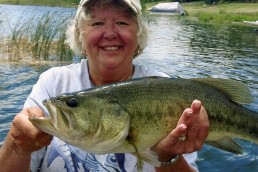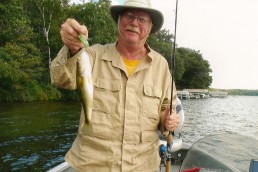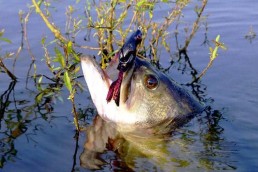SHARE THIS POST
“Oh, my gosh!” I heard my wife yelling from the back of the boat.
I turned to look at her and saw that her spinning rod was bent in half.
“It’s a big fish!” she exclaimed.
I looked out in the water and saw a large silver flash.
“It sure is,” I said, as I dropped my spinning rod, slipped off my chair on the front casting deck to the floor, and grabbed the net.
I heard the drag on her reel whine as it gave out line. Becky was getting the fish closer, but it pulled away each time she tried to get it in range for me to net.
It was a big fish and it went where it wanted to. The fish shot around the back of the boat and Becky swiveled in her chair so she now was fighting it on the other side of the boat.
Again, she was getting this fish closer. I was now standing next to her.
The fish stayed away from the boat, but Becky pulled back on her spinning rod to bring the fish a couple feet closer.
She quickly reeled up the extra line and pulled back again. This time the fish was close enough to net and I stuck the net in the water, bringing it toward the fish’s head.
I pulled up on the net and brought the fish out of the water as it sagged in the mesh, thrashing then spraying water. I reached in, grabbed the fish by the lip, and pulled it out of the net.
I quickly measured it and it stretched to 21 inches against the tape on the side of the boat.
I handed the fish to Becky so I could take photos. Once the photos were done she lowered the fish back in the water and it slowly disappeared.
Becky and I exchanged high-fives and I gave her a hug.
“That is the biggest bass to come into this boat in years,” I told her.
Are you enjoying this post?
You can be among the first to get the latest info on where to go, what to use and how to use it!
We were on a small lake in Wisconsin’s Polk County. It was a warm summer day in midsummer with light breezes and blue skies. It was a lazy type of day, made for fishing.
“That fish came right out of the weeds,” Becky said. “It felt heavy, but came out without much fight at first until it got close to the boat. Then it exploded.”
This lake is a round, sandy-bottomed body of water without much structure. However, it is ringed by a thick mass of weeds, which holds most of the species we catch here.
A good number of the lakes we search each summer have weeds, and understanding how to fish this type of cover makes a big difference in the amount and size of fish we catch in summer. Weeds are a natural attraction to both baitfish and gamefish, and many need to learn which baits to use and where to look in the weeds to be effective.
There are essentially three distinct areas to probe in weed beds: outside the weeds, over the tops and the open water from inside the weeds to the shore. The outsides of weed beds will be closer to deeper water so it has the possibility to attract the bigger fish.
There are a number of baits for this type of water, and I’ll also position my boat in open water, casting to the outer edges of the weeds. Sinking plastic worms work well here. To get them down quicker and deeper, I’ll work wacky jigs. Regular plastic worms fished Texas-rigged with bullet-shaped sinkers are also effective. A pig and jig also works well in these scenarios. Sometimes it helps to add a split-shot sinker 1 to 1 1/2 feet above a sinking worm so that it gets down quicker and stays longer in the target area at the bottom of the outsides of the weeds.
Crankbaits can be effective on the outsides as well. Standard crankbaits, such Shad Raps and Jointed Shad Raps, as well as lipless crankbaits, will be productive.
Working across the weed beds can be effective. Bass will sink in the weeds for protection, to escape the sun and to attack baitfish. These bass won’t be particularly finicky either, as they only have a short opportunity to attack a bait. And they aren’t choosy, so color doesn’t matter as much as it would in other presentations.
Topwater baits such as Chug Bugs, Heddon Torpedos and Scum Frogs can bring explosive strikes. Another favorite bait of mine in these waters are shallow-running crankbaits like Mann’s Baby Minus One. These will run no more than 1 foot below the surface and their erratic wobble drives the bass crazy.
Spinnerbaits and ChatterBaits will also be productive. These can be retrieved just below the water’s surface over the tops of the weeds. Weedless spoons, such the Johnson Silver Minnow and the Fishtrap by the Weedless Bait Company, are also effective over the tops. There will be holes and dips in the weeds. As the bait approaches these, let the bait drift back and down to trigger strikes.
Some of the most overlooked, neglected spots are the spaces between the shore and the insides of weeds. I think too often fishermen don’t search those areas because they think the water is too shallow. It may be shallower water, but it can hold an enormous amount of fish. Because it’s close to a bank, oftentimes the trees and other shoreline vegetation will provide shade, which helps to hold fish.
Sinking plastic worms rigged wacky- or Texas-style are great in these waters. The worm gradually sinks, moving side to side to trigger strikes.
Becky’s big bass was early in the day, and we did continue to work around the lake and the weed beds ringing the body of water. We steadily caught fish and ended in the afternoon with catching and releasing over 40 bass.
The key to catching bass in summer is to understand where to find them and how to fish in, around and on the tops of thick cover. It’s all a matter of weeds.
MWO
SHARE THIS POST
Did you enjoy this post?
You can be among the first to get the latest info on where to go, what to use and how to use it!
Mike Yurk
Mike Yurk grew up in Oshkosh, Wis., where he first started writing about the outdoors. A retired Army officer, he is now a full-time, freelance outdoor writer. He has written more than 1000 articles for outdoor publications and published 12 books on outdoor sports. He lives in northwestern Wisconsin where he has found some of the best bass fishing in the country.


